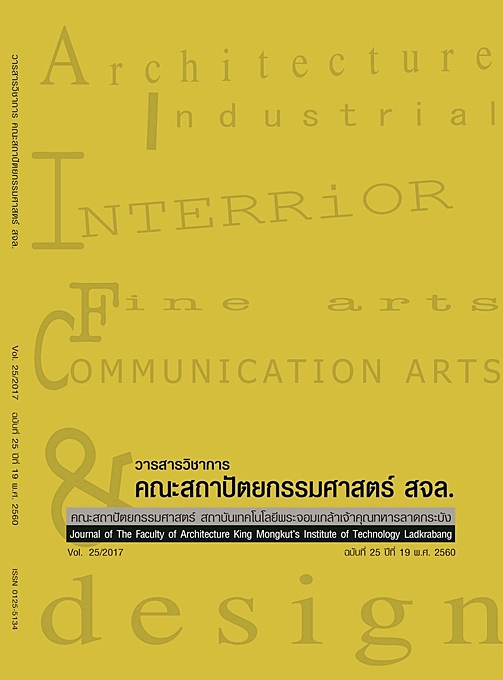ปัจจัยบุคคลกับพฤติกรรมค้นหาเส้นทางภายในมหาวิหารมัสยิดฮารอม ในการประกอบพิธีฮัจย์ของมุสลิมในประเทศไทย (Individual Factor and way Finding in Masjid Al Haram – Makkah Al – Mukarramah to Perform the Pilgrimage for Muslim in Thailand๗
Main Article Content
Abstract
บทคัดย่อ
พิธีฮัจย์ รวมประชาชาติมุสลิมต่างภาษา เชื้อชาติ เผ่าพันธุ์ ฐานะ สีผิว จากทั่วโลก เพื่อสนองตอบต่อคำบัญชาของอัลลอฮ์ การหาทิศทาง เป็นความสามารถเฉพาะบุคคลเพื่อไปสู่จุดหมายที่แต่ละคน จะจัดระเบียบข้อมูลที่ได้รับจาก
สภาพแวดล้อมใหม่ เกิดเป็นแผนที่ในใจในการรับรู้ต่อพฤติกรรมในสภาพแวดล้อม ซึ่งผังมัสยิดทั่วไปเป็นลักษณะสี่เหลี่ยม หันไปทิศกิบลัต ผังมัสยิดฮารอมเป็นที่ที่มีกิบลัตเป็นศูนย์กลาง ที่มุสลิมทุกคนจะต้องกราบไหว้เข้าหากะฮ์บะฮ์ (ใช้เรียกอาคาร
ทรงสี่เหลี่ยมแปลว่า บ้านของพระเจ้า) โดยจัดแถวละหมาดเป็นวงกลม เกิดเป็นสภาพแวดล้อมใหม่ ประเด็นปัญหาการวิจัย 1) เลือกที่นั่งในมัสยิดฮารอมอย่างไร 2) ทำไมบางคนหลงทางในมัสยิดฮารอม สรุปได้ว่า ปัจจัยบุคคลแต่ละคนพยายามจะหา
ที่นั่งเดิมแต่สถานการณ์ สภาพการณ์เกิดการเปลี่ยนแปลงตลอดเวลาเป็นเหตุผลที่นำไปสู่การหลงทางของ เพศชาย เพศหญิงมีอัตราการหลงใกล้เคียงกัน ผู้คนในภูมิลำเนาที่ห่างไกลมีโอกาสหลงมากกว่าคนเมือง แต่รายได้กับระดับการศึกษากลับไม่มี
ผลต่อการหลงทาง และสาเหตุของการหลงทางมากที่สุด คือ ผลกระทบจากงานก่อสร้างต่อเติม ทำให้เกิดการเปลี่ยนทิศทางคำตอบรองลงมา คือ จำประตูทางเข้าผิด จำทิศผิด และมีการอวดรู้ อวดเก่ง สภาพการณ์ของมวลชนที่มีจำนวนมาก ประกอบกับ
สถานที่กว้างใหญ่มากๆ ทำให้รู้สึก สับสน ตื่นเต้น ตื่นสถานที่ ดูเหมือนๆ กันไปหมด การรับรู้ในสภาพแวดล้อมใหม่กับมัสยิดฮารอมนั้นจะต้องเรียบเรียงการเก็บข้อมูลในระบบความจำ ให้เป็นระบบ เพื่อการเรียกข้อมูลในการจำมาใช้ และต้องตัด
การรับข้อมูลแทรก ต้องมีขั้นตอนการฝึกฝน อันเป็นส่วนหนึ่งที่ทำให้มีสติ สมาธิขณะนั้นนิ่ง ไม่ถูกรบกวนจากใดๆ แล้ว การปฏิบัติศาสนกิจจะจดจ่อมุ่งสู่พระเจ้าองค์เดียว ผลตอบแทนได้ครบถ้วน ขอพระองค์ทรงโปรดประทานฮัจย์มับรูรแก่ทุกท่าน อามีน
คำสำคัญ : ค้นหาเส้นทาง แผนที่ในใจ ตอวาฟ ฮารอม ฮัจย์มับรูร
Abstract
The Hajj brings together Muslims with different languages, races, statuses and skin colors from over the world to fulfill the command of Allah. Wayfinding system is the personal competence of an individual to
orient and navigate oneself to a desired destination. Each individual has to arrange the perceived information of the new surrounding and construct a cognitive map. The standard floor plan of the Haram is square facing
to the direction of the Qiblah, which is the west of Thailand. The Qiblah is the direction where Muslims pray toward in the position of Kaaba. During prayer, Muslims line up in circles. The new environment led to these
objectives of the study: 1) how to find their own prayer spot in the Haram? 2) why do some pilgrims get lost in the Haram? This research aimed to study behaviors of pilgrims and offer ways to improve individual behaviors
of Hajjis from Thailand in finding directions in the Haram. From the study, it is concluded that the pilgrims prefer returning to the same prayer spot but the constant changes within the mosque is the major contribution
that has caused them to lose their way within the Haram. The ongoing expansion which entails continuous changing of the pathways and the changing in the arrangement of the rows during prayer also cause confusion
to many pilgrims. The secondary factors include confusion of gates and directions, pretentious characteristic of some pilgrims, the large amount of pilgrims, the excitement, and the similarity of the surroundings. In order
to familiarize oneself with the new environment within the Haram mosque, one will need to collect data and store it in his memory in a systematic manner. To be able to systemically recall the memory, it is necessary
to remove any distracting information. Some certain procedures and practices are required to help the pilgrims stay composed, calm, and free from any distraction which will eventually make them achieve the utmost
concentration and ensure abundant rewards from Allah. May you all be blessed with a successful Hajj.
Keyword: Wayfinding, Cognitive Map, Tawaf, Haram, Successful Hajj
Article Details
This work is licensed under a Creative Commons Attribution-NonCommercial-ShareAlike 4.0 International License.
Copyright Transfer Statement
The copyright of this article is transferred to Journal of The Faculty of Architecture King Mongkut's Institute of Technology Ladkrabang with effect if and when the article is accepted for publication. The copyright transfer covers the exclusive right to reproduce and distribute the article, including reprints, translations, photographic reproductions, electronic form (offline, online) or any other reproductions of similar nature.
The author warrants that this contribution is original and that he/she has full power to make this grant. The author signs for and accepts responsibility for releasing this material on behalf of any and all co-authors.


